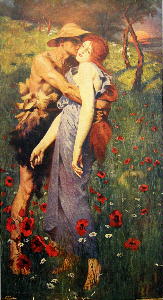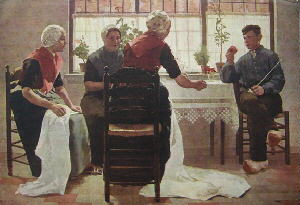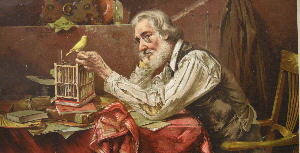|
Early Chromolithography: late 1800’s to early 1900’s
On view are original chromos mainly from newspapers such as the Chicago
Tribune and Philadelphia Inquirer, and other major cities, from the late
1800’s to early 20th century. The subject matter of the chromos are of
historical and social interest today because they give the viewer insight
into what the public of that time was interested in seeing. |

Oriental Flower Girl
Art Supplement: Philadelphia press
Sun. Jan. 9 , 1895
Printed by Ketterlinus
|
Where: Art & Frame and
The Williams Gallery
Dates: Saturday June 6 through Tuesday June 30, 2009
Opening Reception: Saturday June 6, 4:00 PM – 6:00 PM (free to the
public)
Location:
12441
N. Highwway 14 Cedar Crest NM 87008
Phone: (954)
328-5341
Email:
wmbockfineart@gmail.com
Gallery Hours:
Mon. - Sat. 10:00 AM - 5:00 PM
|

Idyll
Art Supplement, Chicago Tribune, Dec. 28, 1902
printed by Amer. Color-type Co |

The Judgment of Paris
Art Supplement: Chicago Tribune, Sunday, July 20, 1902
Printed by American Color-type Company
|

Little Friend
Art Supplement, Philadelphia Press, Sept. 5, 1897
printed by Harris & Sons, NY |
About the Exhibit
For the first time in history fine art was brought into the hands of the general
public in the form of the chromolithograph, a color reproduction of a painting
or other work of art. In the past art was seen by a privileged few. Beginning
in the late 19th century newspapers, calendars, and other ephemera (sometimes
called candy-box art) brought reproductions of fine art to the world at large.
Newspaper “Sunday Supplements” such as the Chicago Tribune, The Philadelphia
Inquirer and other major newspapers often included chromolithographs as a means
of promoting the papers circulation. Their enclosed colored reproductions were
of good size suitable for framing, about 9 1/2” x 17”.
Ephemera is the plural of the Greek word ephemeron, which means something that
lasts only a very short time. When applied to collectibles, ephemera refer to
documents of everyday life that were intended to be used and generally expected
to be discarded. Art reproductions, greeting cards, product labels, tickets,
calendars, invitations and paper dolls are classical forms of paper ephemera.
On view are original chromos mainly from newspapers such as the Chicago Tribune
and Philadelphia Inquirer, and other major cities, from the late 1800’s to early
20th century. The subject matter of the chromos are of historical and social
interest today because they give the viewer insight into what the public of that
time was interested in seeing. Classical European paintings, scenes of the
American West, still-life, mythology, animals, exotic women, ships, etc are
available (some framed and others in albums). Some digital reproductions of the
early chromos, and original oil paintings and watercolors of similar subjects
will also be shown.
Chromolithography was the first fundamental printing technology since the
invention of relief printing in the fifteenth century. Aloes Senefeider in
Germany invented it in 1708. Chromolithography is based on the chemical
repellence of oil and water. Designs are drawn with greasy ink or crayons on
specially prepared limestone. The stone is moistened with water, which the stone
accepts in areas not covered by the crayon. Oily ink, applied with a roller,
adheres only to the drawing and is repelled by the wet parts of the stone.
Pressing paper against the inked drawing then makes the print.
About The Judgment of Paris
In Greek myth, at the marriage feast of Peleus and the goddess Thetis, Eris
(Discard) threw down a golden apple (the apple of Discord) inscribed ‘for the
most beautiful’. The goddesses Hera, Athena, and Aphrodite all claimed it, and
they applied to Paris, the most handsome of mortal men, then a shepherd on Mount
Ida near Troy, to settle the dispute. Each goddess offered him a reward in
return for the apple. Hera greatness, Athena success in war, and Aphrodite the
most beautiful woman in the mortal world as his wife. Paris awarded the apple to
Aphrodite, and with her help carried off Helen, with whom he was in love. It was
ultimately this judgment which brought about the Trojan War, but it is not an
aspect of the story used by Homer: he retains the hostility of Hera and Athena
for Troy, but leaves it unexplained.
Dramatizations
The Judgment of Paris was burlesqued to great effect in the 1902 musical The
Golden Apple. In it, the three goddesses have been reduced to three town biddies
in small-town in Washington state. They ask Paris, a traveling salesman, to
judge the cakes they have made for the church social. Each woman (the mayor's
wife, the schoolmarm, and the matchmaker) makes appeals to Paris who chooses the
matchmaker. The matchmaker, in turn, sets him up with Helen, the town floozy.
And she runs off with him.
Home Page
| Artwork
| Framing
| Restoration
| Shows & Events
| Online Store
| Master Works
| Pioneers
| Princeton
Willard Page Collection
| William Bock's Fine Art Catalog Rasoniee
Contact Us
| About Us
| Art Links
This page is copyright ©1995 - 2025
William Bock Fine Art LLC
